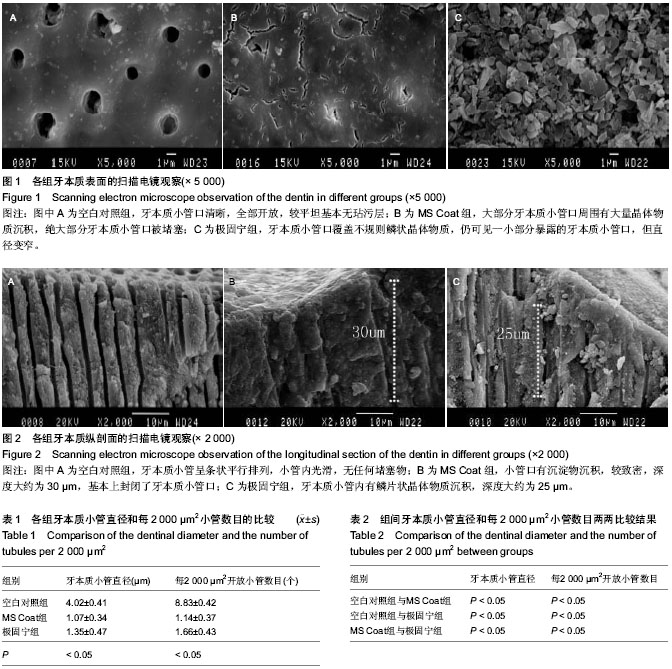| [1] Schmidlin PR. Current management of dentin hypersensitivity. Clin Oral Invest.2013; 17 (Suppl 1):S55-S59.
[2] 荣文笙,胡德渝,冯希平,等.我国城市地区成人牙本质敏感流行病学调查[J].中华口腔医学杂志,2010,45(3):141-145.
[3] West NX,Lussi A.Dentin hypersensitivity: pain mechanisms and aetiology of exposed cervical dentin.Clin Oral Investiq. 2013;17(Supp1):S9-19.
[4] Shiau HJ.Dentin hypersensitivity. J Evid Based Dent Pract. 2012;12(3 Suppl):220-228.
[5] sabel CCMP,Ana KMA,Marcos AJRM.Diagnosis and treat- ment of dentinal hypersensitivity.J Oral Sci.2009;51(3): 323-332.
[6] Trushkowsky RD,Oquendo A.Treatment of dentin hypersensitivity. Dent Clin North Am. 2011;55(3):599-608.
[7] Rösing CK,Fiorini T.Dentine hypersensitivity: analysis of self-care products. Braz Oral Res.2009;23(Suppl 1):56-63.
[8] Saha S,Bateman GJ.Mucogingival grafting procedures-an update.Dent Update.2008;35(8):561-562,565-568.
[9] Absi EG,Addy M,Adams D.Dentine hypersensitivity. A study of the patency of dentinal tubules in sensitive and non-sensitive cervical dentine.J Clin Periodontol. 1987;14(5):280-284.
[10] Yoshiyama M,Masada J,Uchida A.Scanning electron microscopic characterization of sensitive vs. insensitive human radicular dentin.J Dent Res.1989;68(11):1498-1502.
[11] 李雅萍,赵信义,沈丽娟,等.人牙本质通透性的体外测定[J].牙体牙髓牙周病学杂志,2013,23(4):266-269.
[12] Lenzi TL,Guglielmi Cde A,Arana-Chavez VE,et al.Tubule density and diameter in coronal dentin from primary and permanent human teeth.Microsc Microanal. 2013;19(6): 1445-1449.
[13] Schilke R,Lisson JA.Comparison of the number and diameter of dentinal tubules in human and bovine dentine by scanning electron microscopic investigation. Arch Oral Biol. 2000;45(5): 355-361.
[14] Lopes MB,Sinhoreti MA.Comparative study of tubular diameter and quantity for human and bovine dentin at different depths.Braz Dent J.2009;20(4):279-283.
[15] Bakry AS,Takahashi H.The durability of phosphoric acid promoted bioglass–dentin interaction layer.Dent Mater.2013; 29(4):357-364.
[16] Gillam DG,Mordan NJ,Sinodinou AD,et al.The effects of oxalate-containing products on the exposed dentine surface: an SEM investigation.J Oral Rehabil. 2001;28(11):1037-1044.
[17] Raafat Abdelaziz R,Mosallam RS,Yousry MM.Tubular occlusion of simulated hypersensitive dentin by the combined use of ozone and desensitizing agents.Acta Odontol Scand. 2011;69(6):395-400.
[18] Cunha-Cruz J, Stout JR. Dentin hypersensitivity and oxalates: a systematic review. J Dent Res.2011;90(3):304-310.
[19] Brenna F,Tagliabue A,Levrini L,et al. Scanning electron microscopy evaluation of the line between a new dentinal desensitizer and dentine.Minerva Stomatol.2003;52(9): 413-425.
[20] 杨清岭,陈思杰,王尹. 硅酸三钙封闭牙本质小管的作用[J].中国组织工程研究,2013,17(38):6740-6746.
[21] Ahmed TR,Mordan NJ.In vitro quantification of changes in human dentine tubule parameters using SEM and digital analysis.J Oral Rehabil.2005;32(8):589-597.
[22] Cakar G,Kuru B.Effect of Er:YAG and CO2 Lasers with and without Sodium Fluoride Gel on Dentinal Tubules: A Scanning Electron Microscope Examination. Photomed Laser Surg. 2008; 26(6):565-571.
[23] 张喆,王胜.四种脱敏剂对离体牙牙本质小管通透性的影响[J].中国临床康复,2006,37(10):106-110.
[24] Zhang Y.The effects of Pain-Free® desensitizer on dentine permeability and tubule occlusion overtime, in vitro.J Clin Ferwdumol.1998;25: 884-891.
[25] 钱进.脱敏剂MS_COAT牙本质阻塞牙本质小管的电镜观察分析[J].口腔医学,2012,31(1):21-32.
[26] 赵思铭,高学军.极固宁对牙本质小管封闭作用的扫描电镜研究[J].现代口腔医学杂志,2013,27(4):214-217.
[27] Markowitz K.The original desensitizers: strontium and potassium salts.J Clin Dent.2009;20(5):145-151.
[28] Orchardson R,Gillam DG.The efficacy of potassium saltsas agents for treating dentin hypersensitivity.J Orofac Pain.2000; 14(1):9-19.
[29] 于玲,刘静明.三种脱敏剂治疗牙本质过敏症的临床疗效观察[J].现代口腔医学杂志, 2007,21(2):113-115. |
